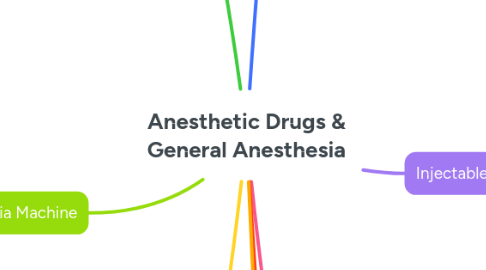
1. Anesthesia Equipments
1.1. Intravenous Catheterization
1.1.1. Common vein
1.2. Anesthesia Mask
1.2.1. vary in size
1.2.2. use to deliver oxygen
1.3. Laryngoscope
1.3.1. Assist in the viualization of the trachea during intubation
1.3.2. vary in size and types
1.4. Endotracheal tube
1.5. Intubation
1.5.1. choose the tube will use
1.5.2. Measure
1.5.3. Pressure make sure are no leaks
1.5.4. Apply a small amount of lubricant
1.5.5. make sure the tube is going into the trachea
1.6. Monitoring Device
1.6.1. Use during anestic procedurg
2. Anesthesia Machine
2.1. Oxygen source
2.1.1. Pressure regulators are located downsteam
2.1.1.1. Pressure of 50 PSI
2.2. Oxygen Flush
2.2.1. Supplies o2 in emetgency directly form high pressure
2.3. Flowmeter
2.4. Vaporizer
2.5. Pop-off valve
2.6. common gas outlet
2.7. A reservoir bag
3. Breathing circuits
3.1. Delivery of oxygen to the patient
3.2. Delivery of the anesthetic gas
3.3. Assintance wirh ventilation
3.4. Breathing circuit types
3.4.1. Rebreathing
3.4.1.1. chemical carbon dioxide absorbers
3.4.1.1.1. Warmed and moistened by the patient
3.4.1.2. Advantages
3.4.1.2.1. Cheaper to run warms
3.4.1.3. Disadvantages
3.4.1.3.1. Vaporizer changes slower to take effect
3.4.2. Non-Rebrathing
3.4.2.1. Physical fresh gas flow
3.4.2.1.1. cold and dry
3.4.2.2. Advantages
3.4.2.2.1. Breath by breath response to vaporizer changes, low resistance
3.4.2.3. Disadvatages
3.4.2.3.1. Higher o2 and inhalation costs
4. premedication
4.1. Give before anestesia
4.1.1. Tranquilizer/Sedative
4.1.1.1. Alpha-2Adrenergic agonists
4.1.1.1.1. Example drugs
4.1.1.1.2. Antidote
4.1.1.2. Phenothiazine
4.1.1.2.1. Example drugs
4.1.1.3. Benzodiazepine
4.1.1.3.1. Antidote
4.1.1.3.2. Example drugs
4.1.2. Opioids
4.1.2.1. Example drugs
4.1.2.1.1. Morphine
4.1.2.1.2. Fantanyl
4.1.2.1.3. Tramadol
4.1.2.2. Antidote
4.1.2.2.1. Naloxone
4.1.2.2.2. Naltraxone
4.1.2.3. Addictive
4.1.2.3.1. use under vet only
4.1.3. Anticholinergic Agents
4.1.3.1. Example drugs
4.1.3.1.1. Atropine
4.1.3.1.2. Glycopyrrolate
4.1.3.2. Clinical use
4.1.3.2.1. Tx bradycardia
4.1.3.2.2. Decrease saliva
5. Injectable Anesthetics
5.1. if add more is prolong recovery
5.2. Barbiturate
5.2.1. Example drugs
5.2.1.1. Pentobarbital Sodium
5.2.1.2. Thiopental Sodium
5.2.2. Clinical use
5.2.2.1. Put to sleep
5.2.2.2. Anestic induction
5.3. Non-Barbiturate
5.3.1. Drugs
5.3.1.1. Propofol
5.3.1.1.1. Clinical use
5.3.1.2. Etomidate
5.3.1.2.1. Clinical use
5.4. Dissociative Anesthetics
5.4.1. Example drugs
5.4.1.1. Ketamine
5.4.1.2. Tiletamine
5.4.1.3. Zoletil
5.4.1.3.1. Tiletamize + Zolazepam
5.5. Neuroactive Steroids
5.5.1. Drugs
5.5.1.1. Alfaxalone
5.5.1.1.1. Clinical use
6. lnhaled Anesthetics
6.1. maintenance of anestheia with inhalation
6.1.1. Simplicity
6.1.2. Reliability
6.1.3. Predictability
6.1.4. Good recovery quality
6.2. Nitrous Oxide
6.2.1. transfers across the alveolus rapidly
6.3. Drugs
6.3.1. Halothane
6.3.2. Isoflurane
6.3.3. Sevoflurane
7. Local Anethetics
7.1. treat painful condition
7.2. prevent pain drugs
7.3. Relieve pain after surgery
7.4. drugs
7.4.1. Liocaine
7.4.2. Mepivacaine
7.4.3. Bupivacaine
8. Anesthesia general protocols
8.1. Preanestic Evaluation and preparation
8.2. permedication
8.2.1. Monitoring
8.3. Anestheic induction
8.3.1. Monitoring
8.4. Anesthetic Maintenance
8.4.1. Monitoring
8.5. Recovery
8.5.1. Monitoring
